Keynotes14
I.
Tibetan Buddhism played an important role in Yuan politics.
Emperors of the Ming, especially emperor Yongle (the second Ming emperor)
have tried to use the influence of Tibetan Buddhist institutions in a similar
way. But it was only under the last dynasty, the Manchurian Qing Dynasty,
that Tibetan Buddhism again gained major importance.
The Mongols had extended
their postal station network to the Tibetan borderlands and well into
Under the Yuan, the
Buddhist clergy was exempted from taxes. Other reasons for an uneasy relation
between the Tibetan clergy and the Chinese population were:
1. The monks pardoned
prisoners on the occasion of Buddhist and Chinese festivals and declared this
to be meritorious.
2. Whoever attacked
Tibetan monks was punished cruelly by the clergy.
3. Tantric sexual practices
were uncommon in Chinese Buddhism.
4. Human sacrifices
were uncommon in Chinese Buddhism.
5. A member of the
lamaist clergy destroyed the imperial tombs of the
Song emperors because they had partly been built on the former sites of Buddhist
temples.
Outside of activities
related to religious practices Tibetans did not hold positions of importance
in the Yuan administration or in the intellectual life of the time. During
this period
The Ming (1368-1644) and Qing Dynasties (1644-1911)
--increased commercialization, and
--making use of the
power of firearms
are the three main most remarkable characteristics for the period labeled
“Late Imperial
The
Ming Dynasty (Chinese; 1368-1644)
The
end of the Yuan saw a rapid inflation, corruption of the Tibetan clergy who
controlled the Chinese clergy and interfered in political affairs, and rebellions
of the exploited Chinese population against Mongol and other foreign officials.
One of the rebellions
attracted the poor monk Zhu Yuanzhang (1328-1398) who later became the head
of a rebel army and successfully fought against the Mongols as well as other
contenders for power.
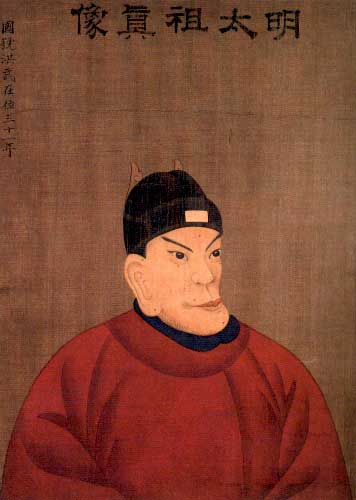
During the Ming the
population more than doubled. When the dynasty was founded the registered
population was 60 Mio. Until the Manchu conquest it increased to 125 Mio.
people. While in former dynasties the population
of the north suffered great losses during invasions and caused the migration
to the south that helped to develop agriculture and commerce in the Jiangnan
area [=the area south of the Yangzi River], a reverse movement began in the
Ming.
The
new migration was not started on a voluntary basis. The Ming government forced
large numbers of families to resettle in the north and in the southwest of
the country in order to cultivate the land, build irrigation sytems,
and integrate it into the sphere of Chinese government.
!!The
growth of the population was due to an increased production of food on formerly
used arable land as well as land that was newly cultivated. The production
of wheat was expanded in the north and new crops were brought to
 The territory of the
Ming dynasty
The territory of the
Ming dynasty
!!The Ming dynasty may be divided into four larger periods:
1. 1368- 1450: The
age of economic reconstruction and installation of new institutions.
Diplomatic and military expansion
were pursued in

Comparison between Admiral Zheng He's 'Treasure Ship' and Columbus' 'Santa
Maria'
2. 1450-1520: A period
of withdrawal and defense after the great expeditions. This period in the
eyes of orthodox Confucians was a time in which commerce disrupted the cycle
of agriculture and began to corrupt society. The polarization of the wealthy
and the poor began.
3. 1520-ca.1580: A
2nd Chinese ‘renaissance’ among Chinese intellectuals during the rules of
emperors Zhengtong and Zhengde could not avert the growing imbalance of agriculture
and commerce. Agriculture, so the orthodox Confucians,
was neglected, commerce dominated the economy. The purity of working the land
gave way to the excesses related to the influence of capital.
Consumption, not necessity, began to drive production.
4. 1580-1644: a period
of crises in commerce, politics, and revolts among urban workers
Society in the initial
century of the Ming was characterized by a search for stability through reconstruction
of the agrarian social system (which had been abandoned as early as the Song
when a commercial revolution had propelled the economy) and at the same time
created physical and social immobility while the population more than doubled.
Important
characteristics:
• Agriculture:
restoration and reclamation of land
reforestation
transfer of immigrants to new territories, land distribution
!!In the beginning
of the Ming travel was discouraged. The maximum radius of travel in which
no route certificate was required was a distance of 58 km.
Transgression of this law was punished (at times by capital punishment) at
the time of return.
Occupations were hereditary.
The society consisted of
• peasants who had to settle in villages,
• artisans who worked in state-service workshops,
• merchants who were only allowed to perform trade in necessities,
• and soldiers who were settled at the frontiers in large numbers.
• A small educated elite whose members were more distrusted than trusted by
emperor Hongwu, managed the administration of the empire.
Registration for purposes
of tax collection: Households were registered in official charts. In order
to recruit household members for duty in the labor service system,
- creating new settlements in the border regions in order to control military
activities of the neighboring peoples or states and
- creating a new social
fabric in the cities especially in the metropolitan areas when households
of former opponents of contenders for power were sent into exile as settlers
of territories that were to be newly cultivated. The population was functionally
divided and distributed.
- Officially approved
physical mobility
was supervised by the Ministry of War which managed
the courier service,
the postal service, and
the transport service.
Courier stations were established every 35 to 45 km. They kept up to 450 horses
and mules, and 50-60 sedan chairs (which had been introduced as a means of
transportation during the Yuan Dynasty) and the necessary amount of carriers.
!!The
47.004 full-time laborers were in charge of maintaining the
!!Labor division between
genders
The ideal of labor division between genders that
complemented the ideal of the four-class society invoked by Emperor Hongwu
at the beginning of the Ming, was summarized in the expression “men plough,
women weave”. Manuals by scholars described the necessary works demanded from
men in agriculture and the diligence required from women by sericulture and
the production of textiles that they produced at home. Ideally men and women
both contributed to the tax payments of their household. The topic of men
ploughing and women weaving became a stereotype that was applied in literature
as well as the arts. The ideology of a peaceful society based on the complementary
work accomplished in the rural household was dispersed among the peasants
as well as the in the chambers of the court ladies. Handscrolls titled “Pictures
of Ploughing and Weaving” showed even palace ladies engaging in the works
of sericulture.
By the mid-Ming, men
were found in an occupation formerly supposedly limited to women. A multitude
of woodblock illustrations in manuals shows male weavers at work. When surplus
production increased consumption, a change of job could be a lucrative decision:
There was a growing
need of artisans in textile production and the industries related to book
production such as woodblock carving, the production of paper and ink, the
porcelain industry, as well as in the production of metal works and in mining.
Therefore many peasants became hired workers and artisans.
!!Labor service
From the beginning of the Ming until 1561 there existed
an elaborate system of labor service obligations that commoners had to comply
with. In addition to taxes in kind, paid in grain and tax silk, later also
cotton they had to fulfill –usually annual- labor service obligations. The
labor service depended on the occupation of the registered male adult (15-60
years of age). It could consist in being conscripted to official building
activities (bridges, dams, dykes, roads, palaces etc.), services like controlling
and maintaining the canals, granaries, courier and postal stations, etc.,
or shift work in the imperial workshops on a regular basis (for instance 1-3
months every year). Shift workers of the imperial workshops had to leave their
families and live and work for the fixed amount of time in the workshops.
The service harmed those conscripted because they lost the income of their
business at home during this period. Therefore labor service was eventually
transformed into payments in silver so that the administration could hire
workers and artisans to do the work.
!!Silver
Under the rule of the first emperor the use of silver as currency was repressed.
An attempt was made to stop all private mining (1438) which turned out to
be little effective although culprits had to face capital punishment. The
Yongle emperor reversed this policy as soon as he began to reign. Silver was
mined wherever possible and accessible in
Silver as a currency gained vital importance when taxes in kind and later
corvée (forced labor) obligations were converted into payments in silver (1561).
The state also gained silver when merchants paid for salt-certificates. These
payments were then used to buy provisions for the soldiers in the border regions.
International Trade
International trade became prominent with the expeditions of Admiral Zheng
He between 1405 and 1433. But soon after the last expedition was concluded
(Zheng He died during on the return trip) the continuation was stopped. Records
and maps of the expedition were officially destroyed which made the one surviving
travel account an especially valuable source on the expedition. International
trade now was limited to coastal trade and (illegal) trade with Chinese trade
posts in
!!In 1525 all ships with more than two masts operating at the southeastern
coast were destroyed by official decree. It was not until 1557 when the Portuguese
were permitted to open a trading post in
!!Literacy
In the Ming literacy on an average level was higher
than during any previous period. There are several indicators for this development:
1. the fast development of the book market. In addition to new editions of
the Classics with commentaries as study aids for the candidates who prepared
for the official examinations and manuals with questions and answers of previous
exams, there were cheap editions of novels and theater plays, instruction
manuals, books on medicine, music notation, calendars etc.
2. For officials and their staff administrative handbooks on ritual and law
regulations, and bureaucratic rules were published.
3. Whole page book illustrations became popular.
4. In order to catch the attention of a large readership, ‘journals’ were
published whose pages were divided into up to four different registers containing
a text, its illustrations, some commentary, and even advertising for new editions,
other books by the same author, the bookseller etc.
5. The amount of woodblock carvers increased (while their wages were lowered).
6. New fonts of characters of reduced complexity in style were created in
order to facilitate speedy carving.
7. Registers of landownership, tithing (lijia)- registers,
and tax books that had to be sent to the Ministry of Revenue were printed.
To keep these registers, the responsible person in the community had to be
literate.
8. Standardized printed contracts were used widely for buying and selling
land as well as in commercial activities. The forms were filled in by the
parties or by a hired scribe but had to be signed by the parties. Brook mentions
a contract signed by a woman.
9. The demand made by Emperor Hongwu at the beginning of his reign to establish
community schools for adults in order to improve their ability to read and
write may have contributed to the increased literacy, although it is difficult
to prove that this demand was fulfilled and community schools prevailed over
time. They are scarcely mentioned in local gazetteers. Among other objectives
the empeor aimed at a wide distribution of his own book “Grand Pronouncements”
in order to spread his ideals of law and order.
10. Standardized editions for school textbooks were printed.
11. The production of ink and paper increased.
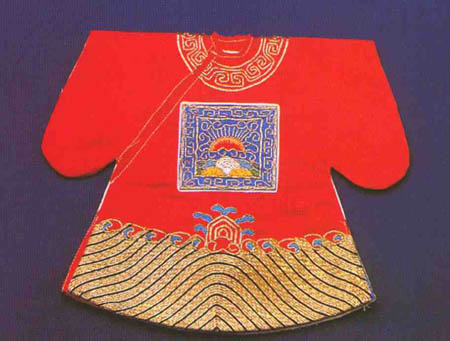 Ming robe
Ming robe
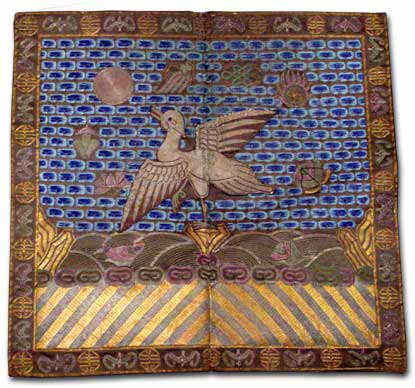
!!Mandarin square: rank badge for the official robe of a Ming civil official
!!Ming Religious Syncretism:
Three Teachings United in One
Since the Song Dynasty
religious and philosophical thinking in
Daoism, and Buddhism were integrated into a system of metaphysical ideas and
practical ethics that only in the Ming Dynasty became widely acknowledged.
The synthesis of the three teachings was the answer to the search for practical
methods of spiritual cultivation.
The
Qing Dynasty (1644-1912)

The territory of the Qing dynasty
The
reign of the Qing
Dynasty is linked to three remarkable rulers:
!!1. Emperor Kangxi (r. 1622-1722): created a government
system in which higher ranking positions were headed by a one Manchu and one
Chinese official each. Kangxi was well learned in the Chinese Classics, literature, as well as
Western mathematics, natural sciences, and mechanics. His intellectual
exchange with the Jesuits led to the appointment of a Jesuit as head of the
imperial Office of Astronomy. He tolerated Christianity as taught by the Jesuits
who allowed for the practice of the ancestor cult by their Chinese converts.
When the pope sent an emissary to
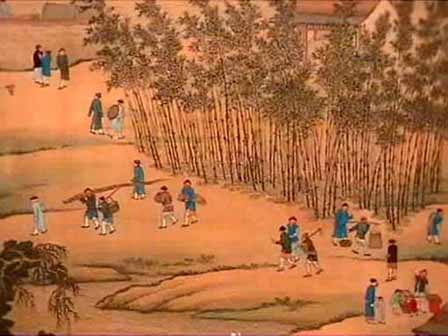
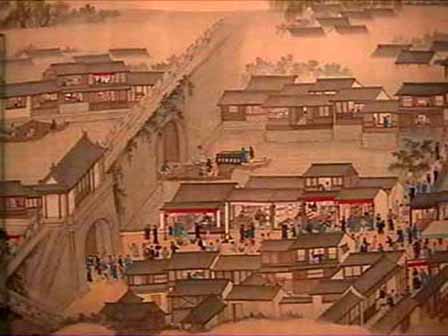
2. Emperor Yongzheng (r. 1722-1736): is best known
for having consolidated the state finances by introducing a reformed tax system.
He also abolished inherited positions.
!!3. Emperor Qianlong (r. 1736-1796
): was a highly cultured person. Although said to not have excelled
in poetry, he composed 42.000 poems (and wrote many of them onto famous paintings…).
Later in life he became extremely afraid of conspiracies and started a literary
inquisition. In 1771 more than 350 scholars reviewed and annotated more than
10.000 books and manuscripts from imperial collections and from collections
in the entire empire.
 Emperor Qianlong
(r. 1736-1796)
Emperor Qianlong
(r. 1736-1796)
The Manchu, Mongol,
and parts of the Chinese population were integrated into civil-military units
called banners which again were divided into smaller units of approximately
7500 households each. The eight basic banners were identified by a colored
flag (yellow, white, blue, red) with a straight or bordered edge. After more
groups of the population had been integrated, there were 24 banners. By 1648
only 16% of the bannermen were of ethnic Manchu origin.
Banners were units
in charge of registration, conscription, taxation, and mobilization. The army
was led by Manchu aristocrats who were assisted by Chinese generals. The Mongols
were fully politically integrated into the Manchu state when the seal of the
Great Khan came into the possession of the Manchu rulers in 1635 after a victory
of the Manchu over the Mongol army. Possessing the Great Seal aligned the
Manchu ruler with Chinggis Khan, who had first united the Mongols in a strategy
similar to Nurhaci’s unification of the Manchus.
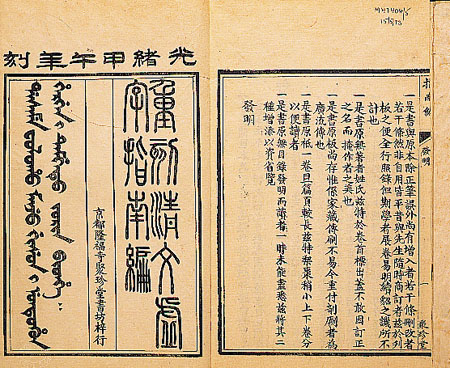
New Institutions:
The Imperial Household
Department was an institution newly created in 1661 that replaced the eunuchs
in the management of the imperial household. (Eunuchs continued to work as
servants in the harem only.) Now Chinese bondservants and officials
-managed the budget of the imperial clan
- provided for the emperor’s food, clothing, housing
- managed the imperial printing bureau
- managed the estates in
the bannermen
- supervised the monopolies of the sale of ginseng,
salt, and pearls, the coin-copper
trade with
- the customs offices
!!Officials’ ranks and examination system
Officials were graded in 9 ranks with an additional division in a (higher
ranking) and b (lower ranking) attributes.
To obtain an official position exams on the
prefectural
provincial and
national levels had to be passed.
Social relations
The Machu government
faced the danger as well as the usefulness of the well-educated local elites.
They could serve the local communities well, but at the same time they could
also take over government functions which were part of the officials’ duties.
In order to limit their influence, tax-exemption practices were changed: tax
and corvee exemptions were no longer granted to the household but now only
to the individual.
!!A ban of intermarriage
between Han and Manchu proved to be impossible to enforce. Nevertheless, Qianlong
insisted on the use of the Manchu language and learning of the Manchu script
by the Manchu population. To preserve Manchu history and tradition he ordered
the Manchu history to be written, the history of the eight banners, the publication
of Manchu genealogies and the recording of the shamanistic tradition of the
Manchu.
Foreign Relations
The tributary system
functioned as it had under the Ming: envoys from
The
relations with
Social Relations
Kinship
The basic unit of production
and consumption was, as it always had been, the family clan using a common
budget and common property. The clan was presided over by a patriarch who
made the essential decisions about family matters (marriage alliances between
surnames, usually diversified careers of sons, punishments etc.). ‘Membership’
in a clan was indicated by the common family name; family organization strived
for joint efforts to keep up shared rites of passage, gravesites, elaborately
constructed ancestral halls in which the ancestral tablets were displayed,
education for the children, and recording the clan genealogy. These shared
institutions and activities especially in south and central
Economic diversity
and growth
Agriculture remained
the most important resource of the Qing state. In labor intensive cereal production
the majority of the work force of peasants was absorbed. Two zones are dominant
for two different crops: In the north wheat and millet are dominant,
the south is the area of wet-rice cultivation. Distributing the risk of a
bad harvest between landlord and tenants in a share cropping system was dominant.
Landownership could be shifting, but largely was limited to members of the
same clan; complete alienation from the land appeared usually only over a
period of several decades. Tenure could be permanent which in general benefited
the tenants because the system offered a high level of security.
The dense population in the south had to devote much of its work time to the
irrigation process and to the maintenance of the irrigation system.
!!“Native banks” handled
nearly all money transfer transactions we know of modern banks. They
-accepted deposits
-made loans
-issued private notes
-transferred funds between regions etc.
within the monetary system which used copper coins, silver, silver dollars,
and paper notes.